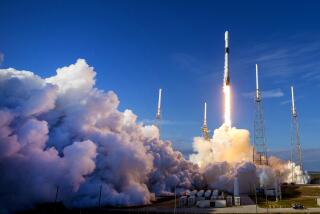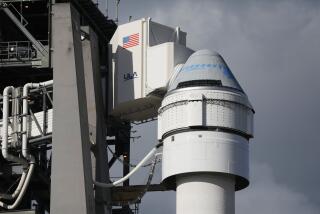Sensor Scrubs Shuttle Launch
- Share via
KENNEDY SPACE CENTER, Fla. — The long-awaited launch of the space shuttle Discovery was postponed Wednesday after a sensor in the liquid hydrogen fuel tank malfunctioned, pushing the liftoff to Saturday at the earliest.
The seven-member crew was already on board when mission managers scrubbed the flight about 2 1/2 hours before the scheduled launch at 12:51 p.m. PDT.
NASA managers acknowledged that they had previously investigated intermittent electronics problems involving the same sensor system on the external tank but could not resolve the problem.
“It is still an unexplained anomaly,” said N. Wayne Hale Jr., deputy shuttle program manager.
NASA’s top shuttle managers were expected to meet all night to analyze the failure.
“I had one mission for the Defense Department that scrubbed 14 times before it got off the pad,” said NASA Administrator Michael D. Griffin. “This is nothing.”
The problem sensor is inside the main fuel tank, which contains liquid hydrogen. It reported that the tank was nearly empty after it had been topped off with fuel.
The sensor’s job is to cut off the shuttle’s engines before the liquid hydrogen tank runs empty, which could cause a catastrophic engine failure.
Normally, the main engines cut off when the shuttle reaches its proper velocity -- well before the fuel is depleted.
But if the shuttle uses more hydrogen than expected, the sensor intervenes and orders an automatic cutoff when 95% of the hydrogen has been consumed. A similar system guards the oxygen tank.
A faulty sensor system could allow the engines to continue firing after the fuel has been depleted or wrongly shut down the engines during launch -- equally dangerous situations.
For that reason, the shuttle has four redundant hydrogen sensors, and the agency requires all of them operate correctly before launch.
NASA officials said Wednesday they were uncertain whether the problem was caused by parts inside the sensor, wiring or associated electronics.
Technicians began to drain the external tank and remove an access door to inspect the sensor Wednesday.
A similar problem involving electronics on the external tank occurred during a test on the launch pad in April.
Maintenance workers replaced the external fuel tank. The specific cause of the malfunction was never determined.
“Unexplained anomalies are the worst,” Hale said. “A problem that comes and goes is a tough one.”
Although some outsiders had advocated a second tank test after the April malfunction, NASA officials defended their decision to move forward with the launch. They said the problem that surfaced Wednesday may not have arisen in a second tank test.
But some outside experts were concerned that NASA had moved forward without solving the problem.
“The machine was trying to tell them something and they chose to ignore it,” said John Pike, executive director of GlobalSecurity.org, a research firm in Alexandria, Va. “Maybe it was trivial, but in both the Columbia and Challenger accidents the machine was talking and they didn’t listen.”
If major repair work is required, it could delay Discovery’s launch until fall. There are only a few periods that allow the shuttle to rendezvous with the International Space Station, which is Discovery’s goal.
The current launch period ends July 31; the next begins Sept. 9.
The scrub was a downbeat ending to an up-and-down day at the Kennedy Space Center.
The launch has attracted enormous attention as the first since the loss of Columbia 29 months ago after a piece of foam debris tore a hole in the orbiter’s left wing. The accident plunged NASA into a lengthy period of mourning and self-analysis from which the agency is only now emerging.
Until the fuel sensor problem occurred, the biggest worry was the weather.
A bright morning quickly gave way to a gloomy early afternoon. Thunderstorms moved in and a steady rain fell as the seven smiling astronauts, led by shuttle commander Eileen Collins, donned their bright orange uniforms and boarded a van for the drive to launch pad 39B.
Because summer weather is unpredictable in central Florida, it took a minute-by-minute analysis by Air Force experts to determine if a sufficient hole would open in the clouds.
Additional ground cameras were added after the Columbia disaster to spot potential damage from debris during liftoff, requiring better viewing conditions than ever before.
In addition, NASA requires a clear 20-nautical-mile zone around the launch pad in case the launch is aborted and the orbiter has to return to Kennedy.
The storm later moved off, leaving crystal blue skies filigreed with cottony clouds.
Traffic along roads leading to the Atlantic beaches was bumper to bumper. In Titusville along Highway 1, hawkers sold stuffed bears in space suits and other mission trinkets. Some visitors arrived the night before and camped out in motor homes and tents.
The day’s excitement wilted with the delay, but most visitors were understanding.
“I’d rather they wait and get things right than have another accident,” said Bill Riemenschneider, a metal sculptor from New York state who had come to watch the launch.
*
Times staff writer John-Thor Dahlburg contributed to this report.
More to Read
Sign up for Essential California
The most important California stories and recommendations in your inbox every morning.
You may occasionally receive promotional content from the Los Angeles Times.











